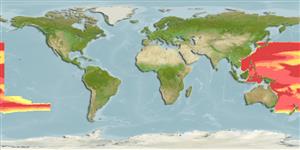Elasmobranchii (tubarões e raias) (sharks and rays) >
Squaliformes (Sleeper and dogfish sharks) >
Etmopteridae (Lantern sharks)
Etymology: Etmopterus: Greek, ethmos, -ou = sieve or ethmoides bone + Greek, pteron = wing, fin (Ref. 45335).
Eponymy: The fallen angel Lucifer, of the Judeo-Christian tradition, is referred to in the fourteenth chapter of the Biblical book of Isaiah: ‘How art thou fallen from heaven, O Lucifer, son of the morning! How art thou cut down to the ground, which didst we [...] (Ref. 128868), visit book page.
More on authors: Jordan & Snyder.
Issue
Research shows that this species is restricted to northwestern Pacific ; Austral-Indonesian records are considered to represent two or three undescribed species (see Ref. 87957); distribution will be resolved (linked to correct species) when publications are received.
Environment: milieu / climate zone / intervalo de profundidade / distribution range
Ecologia
marinhas pelagic-oceanic; intervalo de profundidade 150 - 1357 m (Ref. 106604). Deep-water; 40°N - 48°S
Western Pacific: Japan to Philippines.
Length at first maturity / Tamanho / Peso / Idade
Maturidade: Lm ?, range 34 - ? cm
Max length : 55.0 cm TL macho/indeterminado; (Ref. 122636); peso máx. Publicado: 775.00 g (Ref. 122636)
Espinhos dorsais (total) : 2; Espinhos anais: 0. Dark grey (Ref. 6577) or brown dorsally, black ventrally, with a distinct black streak above and behind pelvic fins; fins lighter; belly luminous (Ref. 26346). Small and slender with a moderately elongate caudal peduncle and with flank denticles mostly arranged in regular rows. The base of the pelvic flank marking is under the second dorsal-fin spine, the anterior branch is usually longer than the posterior branch, and the caudal marking is considerably longer than the precaudal marking (Ref. 6871).
Body shape (shape guide): elongated.
Found on the outer continental and insular shelves and upper slopes (Ref. 247). Its luminescent belly may attract prey (Ref. 26346), which consists mainly of squid (reported to bite squid bigger than itself), small bony fishes, and shrimps (Ref. 247). Often caught in large schools which may suggest that the luminescence may also be used to keep the group together in the dark deep ocean (Ref. 26346). Ovoviviparous (Ref. 205), size at birth about 15 cm (Ref. 6871).
Life cycle and mating behavior
Maturidade | Reprodução | Desova | Ovos | Fecundidade | Larvas
Presumably ovoviviparous (Ref. 6871). Size at birth about 15 cm (Ref. 6871). Distinct pairing with embrace (Ref. 205).
Compagno, L.J.V., 1984. FAO Species Catalogue. Vol. 4. Sharks of the world. An annotated and illustrated catalogue of shark species known to date. Part 1 - Hexanchiformes to Lamniformes. FAO Fish. Synop. 125(4/1):1-249. Rome, FAO. (Ref. 247)
Categoria na Lista Vermelha da IUCN (Ref. 130435: Version 2025-1)
Ameaça para o homem
Harmless
Utilização humana
Pescarias: sem interesse
Ferramentas
Relatórios especiais
Descarregue XML
Fontes da internet
Estimates based on models
Preferred temperature (Ref.
123201): 6.7 - 14.6, mean 9.6 °C (based on 350 cells).
Phylogenetic diversity index (Ref.
82804): PD
50 = 0.5000 [Uniqueness, from 0.5 = low to 2.0 = high].
Bayesian length-weight: a=0.00245 (0.00160 - 0.00376), b=3.07 (2.94 - 3.20), in cm total length, based on LWR estimates for this species & Genus-body shape (Ref.
93245).
Nível Trófico (Ref.
69278): 4.2 ±0.3 se; based on diet studies.
Resiliência (Ref.
120179): Muito baixo, tempo mínimo de duplicação da população maior que 14 anos (Fec assumed to be <10).
Fishing Vulnerability (Ref.
59153): Moderate vulnerability (42 of 100).
🛈
Nutrients (Ref.
124155): Calcium = 8.37 [1.63, 45.94] mg/100g; Iron = 0.348 [0.084, 1.304] mg/100g; Protein = 19.1 [16.5, 21.3] %; Omega3 = 0.331 [0.114, 1.053] g/100g; Selenium = 10.4 [2.6, 35.8] μg/100g; VitaminA = 31.4 [5.4, 200.3] μg/100g; Zinc = 0.478 [0.223, 0.979] mg/100g (wet weight);
